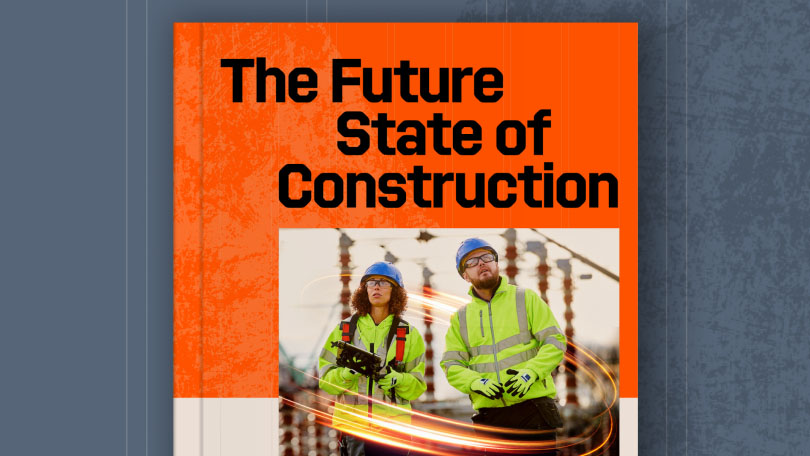— 6 min read
‘Descriptive’, ‘Diagnostic’, ‘Predictive’ and ‘Prescriptive’: Understanding construction analytics
Last Updated Nov 28, 2025
Last Updated Nov 28, 2025

As construction companies continue to make progress towards the goal of becoming truly data-driven, there has been a surge in interest in construction analytics. This is a positive sign for an industry that is often accused of being slow to digitally transform. However, interest doesn’t always equate to understanding. The complex discipline of analytics can send professionals down a rabbit hole, which is why it can be valuable to simplify the concept and take it back to basics.
Table of contents
The Four Types of Construction Analytics
A good place to start is defining four different subsets of analytics which are particularly valuable in construction: descriptive, diagnostic, predictive and prescriptive analytics.
Descriptive analytics uses project data to describe the status of a project or certain outcomes. It provides insights into trends, patterns and performance. This is usually the easiest form of analytics and results in dashboards that are manifestations of the data you already have.
Diagnostic analytics builds on from descriptive analytics — which is like the ‘what’ of the data — to tell you the ‘why’. By analysing historical construction data, diagnostic analytics helps you to determine the root cause of an outcome such as cost overruns or delays.
Predictive analytics relies on both historical data and real-time information to come up with forecasts for future outcomes. It can help you predict risks, resource requirements and timelines, and using it allows you to make data-driven decisions to prevent or enable certain results.
Prescriptive analytics uses project data, mathematical models and algorithms, as well as machine learning and AI, to make recommendations to enable better project outcomes.
Whichever type of analytics you are working with, it’s important to be clear about the reason why you are using it. Instead of just collecting data indiscriminately, start with a hypothesis of what it is you believe is happening on a construction project and why. Then, in the same way you would do a scientific experiment, you perform data analysis to either prove or disprove that hypothesis. In turn, that might lead to more hypotheses, whether they’re diagnostic, predictive or prescriptive.
You don’t have to come up with one killer hypothesis from the start, you just come up with one, test the function and the way it works, and in the same way that you would approach a scientific method, keep experimenting with it.
Matthew Osment
Founder
Shift - Digital Construction
The Three Cs of Data Analytics
The three Cs of data analytics are a good framework to help you approach your construction data analysis with the right mindset. These Cs are:
Curiosity
Approach a data analytics initiative with an open mind and ask questions about how you can improve the ways that work is undertaken based on the data.
Creativity
Remove the biases that keep you doing things the same way. Embrace flexibility and out-of-the-box thinking to find new solutions.
Critical Thinking
Don’t accept numbers at face value: interrogate the source, context, meaning and impact of data to separate ‘noise’ from the critical information.
Approaching a data analytics initiative with curiosity, creativity and critical thinking helps you to see beyond the obvious ideas and vanity metrics to get to the value that might be hidden in the numbers. This can enable you to identify patterns, reveal opportunities for improvement, test assumptions and reframe problems so that stakeholders can see them differently.
Proving the Value of Analytics
Data analytics, when performed well, can be the catalyst for dramatic improvements for construction companies. However, many firms are stuck at the descriptive analytics phase, as this is the simplest form of analytics to undertake.
Moving towards diagnostic, predictive or prescriptive analytics requires more investment — of both time and money — so you need a strong business case to win the hearts and minds of stakeholders. This is where your hypothesis brainstorm can help. Start small, with a simple idea of how your chosen form of analytics will create savings or better outcomes for the company and build a case for how and why you should experiment with it.
But there is another hurdle to jump before you can get stuck into making data-driven discoveries: successfully communicating that value to stakeholders. Spreadsheets and Gantt charts aren’t the best way to win over a sceptical stakeholder, as it is hard to relate these sprawling datasets to real life outcomes — even though they are commonly used methods for displaying data or changes to a programme. It helps to simplify what you want to show them and put it into an easily digestible, visually led format.
When it comes to sceptics, I’ve often found that if I can put something together that demonstrates the output visually, people are convinced relatively quickly. No one is obstructive for the sake of it. They just simply haven’t been shown clear proof before.
Matthew Osment
Founder
Shift - Digital Construction
As soon as you can show stakeholders clear proof, backed up by data, of how you can change things for the better, they become a lot more receptive. This can help you make the move from descriptive analytics to diagnostic, prescriptive and predictive use cases. A simple chart with a narrative that takes them through the journey of the data is a great approach.
I’ll usually create a chart and write a two-page document that explains the proposition. It helps to take them through hypotheses that didn’t work, too, so they can see you have iterated and tested your ideas.
Matthew Osment
Founder
Shift - Digital Construction
Simple Metrics to Enhance Your Analytics Initiatives
There are some metrics that companies might not think to track but that can lead to helpful discoveries that enable diagnostic and predictive analytics as the data builds. Here are two straightforward examples, and how they can help:
Machinery Status
There are companies out there, with one example being Plinx, that offer machine tracking systems. They track where every machine is and use cameras and AI to measure, for example, how much earth they are moving. They can look at components such as the alternator of the vehicle to see when its power consumption versus its output is drifting. This gives you insights into when the performance of the machine is dropping, which can enable predictive maintenance: it tells you when you need to check on the machine’s functionality before it breaks down. When you don’t have that information, you’ll run it into the ground until it’s offline, which leads to more extensive repairs or even the need to replace it entirely.
Gate Delivery Movements
There are certain disciplines, such as concrete pouring, where the deliveries are constrained by the weight of the material. You can have, for example, a 6m3 truck or an 8m3 truck. It’s very rare that a team would let concrete leave site in the truck as they’d be losing money, so the number of deliveries dictates the amount of concrete you’ve received. By looking at the deliveries and numbers of trucks, you can then understand how much concrete you’ve poured. This allows you to measure the progress of concrete pouring with the simplest and easiest metric to track possible. It’s an easy-win metric because you’re capturing it anyway.
Think about the data you are already tracking but might not be using to its fullest potential, and apply the three Cs: be curious, use your critical thinking and see if there is a creative way to use the data you already track to make diagnoses or predictions about how things happen on site.
Categories:
Written by
Explore more helpful resources

Control the Chaos: Standardising Document Workflows in Construction Projects
Document control and implementation play a central role in managing risk, meeting deadlines, and delivering projects to spec. As builds become more complex and teams increasingly disperse, the volume and...

Cost-Plus Construction Contracts in the UK
A construction cost-plus contract – sometimes called a cost-reimbursable or prime cost contract – reimburses all project costs and adds a fee to cover the contractor’s overhead and profit. UK...

Digital Construction Technology for Whole-Life Value
For decades, the construction industry has kept a narrow focus on capital cost — the one-time, upfront costs of a construction project. While in the short term this seems like...

UK Construction Progress Reports: Tools for Smarter Site Management
Construction progress reports track completed work, on site issues, costs, and safety so UK project teams can demonstrate progress, secure payments, and stay on programme. Accurate progress data is essential...
